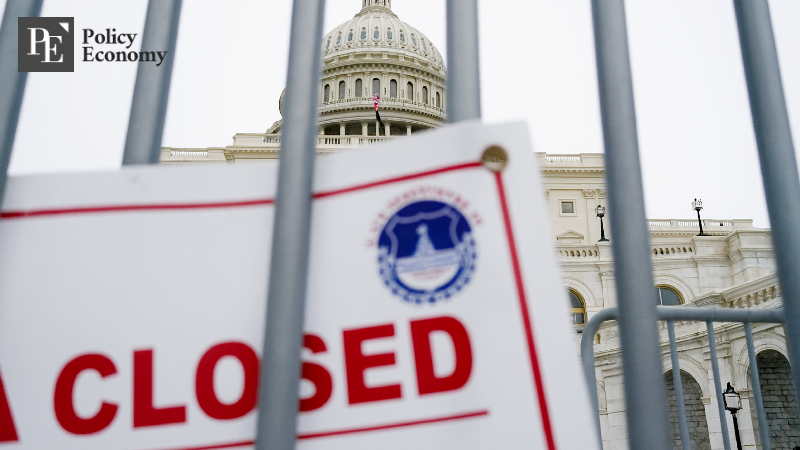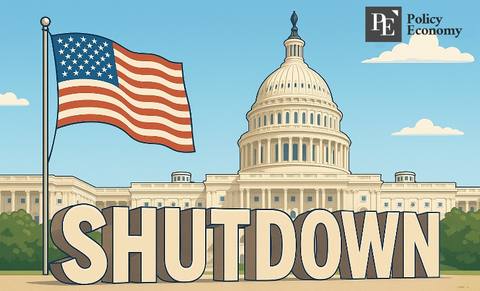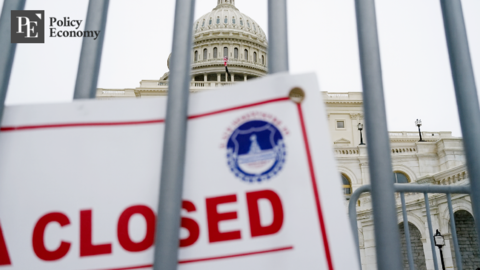Trump Deploys Shutdown as Political Weapon, Weak Dollar and Mass Layoff Scenario Materialize
Input
Modified
Senate Rejects Stopgap Bill, First Shutdown in Seven Years Partisan Stalemate over Obamacare Subsidy Extension Trump Blames Democrats, Warns of Federal Workforce Cuts

The U.S. federal government has shut down for the first time in seven years after Congress failed to pass a budget, cutting off funding. President Donald Trump appears to be leveraging the “shutdown” as a political opportunity to advance his agenda of mass layoffs, a weaker dollar, and rate cuts. Federal workforce reductions to ease the debt burden and monetary easing align with Trump’s preferred scenario. Far from weakening his hand, the shutdown has amplified his agenda. Border enforcement and trade tariffs remain funded as essential functions, while appropriations for Democratic stronghold projects have been suspended under the cover of the shutdown. Democrats, unwilling to tolerate a dynamic that plays to the administration’s advantage, are striking back with a short-term funding push and unified strategy.
Shutdown Begins at 12:01 a.m. on October 1
According to Reuters, the shutdown began at 12:01 a.m. on October 1, halting large portions of government activity. This marks the first shutdown since Trump’s second term began on January 20, and the first since December 2018, roughly seven years ago.
The impasse arose when Congress failed to approve either a full-year budget or a continuing resolution (CR) by the September 30 fiscal year deadline. On September 30, the Senate voted on a seven-week Republican CR but it failed 55-45, short of the 60 votes required. A Democratic alternative was also rejected.
Lawmakers had long clashed over health insurance funding. Republicans had passed a “clean” CR in the House on September 19, but Senate Democrats blocked it. Democrats are demanding an extension of Affordable Care Act (ACA) subsidies, set to expire at year’s end, while Republicans reject the condition.
Last-minute talks at the White House on September 29 failed. On the first day of the shutdown, Senate attempts to advance both Republican and Democratic CRs also collapsed, leaving the shutdown to persist until the next scheduled vote in two days.
The Antideficiency Act mandates that without congressional appropriation, government funding ceases. Consequently, most agencies suspend operations until new appropriations are approved. Federal salaries are halted: essential personnel in law enforcement, border control, and public health work without pay, while nonessential workers are furloughed. Military personnel, air traffic controllers, TSA officers, and public hospital staff remain on duty, with pay deferred until after the shutdown ends.

Shutdown as Opening for Layoffs, Rate Cuts, and a Weaker Dollar
Trump, deflecting all blame onto Democrats, views the shutdown as a chance to execute his domestic agenda. Since the start of his second term, he has pushed for government restructuring to deliver tax cuts. The Congressional Budget Office estimates that roughly 750,000 federal workers will be furloughed—effectively placed on temporary, unpaid leave.
Having advocated large-scale workforce reductions, Trump is signaling more layoffs ahead. On September 30, he declared: “Democrats want the shutdown. When it happens, there must be layoffs. Many people will be laid off.” The White House reportedly ordered agencies to prepare termination plans last week, including the permanent elimination of positions deemed low-priority under Trump’s policy framework.
The dollar’s immediate slide aligns with Trump’s long-articulated weak-dollar policy. On October 1, the dollar index fell 0.2% to 97.54 against the yen basket, its lowest since September 24. The index has now declined 10% year-to-date, the steepest drop in 22 years, reflecting concerns that the shutdown undermines U.S. creditworthiness.
Dollar weakness may persist as the Federal Reserve is widely expected to cut rates twice more this year. According to ADP data released October 1, private payrolls fell by 32,000 last month, far short of the forecasted 50,000, underscoring a sharp slowdown. Futures markets at the Chicago Mercantile Exchange are now pricing in a 99% probability of a 25 basis point cut at the October FOMC meeting. Lower rates drive capital outflows and weigh on the dollar—both outcomes consistent with Trump’s policy direction.
That border enforcement and Immigration and Customs Enforcement (ICE) operations remain fully funded further suggests Trump is treating the shutdown as an opportunity. ICE already has funding under the July-passed “One Big Beautiful Bill (OBBB),” shielding it from disruption. Likewise, the Commerce Department and U.S. Trade Representative (USTR) confirmed that trade policy will continue unaffected, preserving Trump’s tariff agenda.
Democrats Counter with ‘Plan B’ Short-Term Spending Bill, Call for Unity
Democrats are preparing a short-term measure to reopen the government quickly. Axios reports Senate Majority Leader Chuck Schumer has drafted a stopgap bill to resume operations within 7–10 days of the shutdown, dubbed “Plan B.” Unlike Republicans’ seven-week CR, the ultra-short-term funding bill would require unanimous consent in the Senate—forcing any single Republican dissenter to bear political responsibility for prolonging the closure.
The strategy is designed to disrupt Republican leaders John Thune in the Senate and House Speaker Mike Johnson, who have relied on delay tactics. Democrats intend to regain leverage at the negotiating table with only a brief reopening. Beyond Obamacare subsidies, deep divisions remain over deficit management, defense spending, and welfare allocations. Republicans favor prolonged CRs to buy time, while Democrats aim to apply pressure with short-term funding.
Some Democrats argue the party must hold firm even if it prolongs the shutdown, betting public opinion will turn against Trump. Representative Pete Aguilar of California said suspended infrastructure funds in New Jersey would alienate commuters and shift sentiment ahead of next month’s gubernatorial race. Virginia Senator Mark Warner noted federal employees in his state “want us to fight back.”
This time, Democratic governors are signaling they will not step in to cover essential services as they did in past shutdowns. New York Governor Kathy Hochul warned at a press conference in front of the Statue of Liberty: “The torch, which has always been a beacon, could literally go dark.” The stance contrasts sharply with 2018, when New York funded the monument’s reopening during Trump’s first-term shutdown.
After years of criticism for failing to check Trump’s unilateral style, Democrats now appear determined to stand their ground. This shutdown has become not just a fiscal battle, but a defining test of political resolve.





















Comment